Brazil FPS Dominance: How Brazilian Gamers Rule the FPS World
Updated On: August 23, 2025 by Aaron Connolly
Origins of Brazilian FPS Dominance
Brazil’s journey to FPS supremacy really comes from a wild mix of competitive passion and surprisingly accessible gaming setups. The country’s football obsession, mixed with early Counter-Strike hype and the explosion of internet cafés, set the stage for something special.
Early Influences on FPS Culture
Brazilian gamers found their FPS groove with Counter-Strike in the early 2000s. The tactical gameplay just clicked with a culture already obsessed with strategic moves thanks to football.
Counter-Strike was the spark that lit the fire for competitive gaming. While other regions dabbled in different genres, Brazil just dove headfirst into first-person shooters. The teamwork and fast decisions in CS? That’s the same stuff Brazilians loved about football.
Sports in Brazil already built a foundation for fierce competition. The mindset that made footballers into legends just shifted over to digital arenas. Brazilian players brought the same focus and strategy from the pitch to the PC, applying it to traditional sports and games alike.
Some big early influences:
- Counter-Strike 1.6 – The one that got everyone hooked
- Team-based strategy – Fit perfectly for football fans
- Competitive culture – Borrowed from sports infrastructure
This early embrace of FPS games raised a whole generation who knew that mastering these games took as much grit as chasing a football dream.
Rise of Competitive Gaming
Brazilian pro teams started popping up in the mid-2000s. Gabriel “FalleN” Toledo led the charge, and his team snagged back-to-back Major wins at MLG Columbus and ESL Cologne in 2016. They showed the world that Brazilian tactics could outsmart even the toughest European teams.
Those wins didn’t just happen by luck. Brazilian squads cooked up unique strategies that threw international rivals off their game. They mixed raw individual flair with next-level teamwork, and other regions just couldn’t keep up.
Success snowballed from there. Young gamers across Brazil watched their heroes win big and realized maybe they could go pro too. Suddenly, money started pouring into gaming orgs, and better training facilities and coaching became the new normal.
Tournament moments that changed the game:
- 2016 MLG Major – Brazil’s first huge win
- ESL One Cologne 2016 – Cemented Brazil’s tactical edge
- Regional championships – Built a fierce local scene
This era made Brazil a region that raised players differently. Europeans cared a lot about individual skills, but Brazilians doubled down on teamwork and wild new strats.
Role of Internet Cafés in Popularisation
Internet cafés basically became Brazil’s FPS bootcamps. These spots gave kids access to fast PCs that most families couldn’t dream of owning at home.
LAN houses charged about £2 an hour, so even teenagers from working-class backgrounds could jump in. Players like Ana “Viper” Costa cut their teeth in these cafés, spending their allowance to play against tough local opponents.
The café vibe naturally turned into mini-tournaments and rivalries. Everyone played for bragging rights and sometimes a bit of pocket change, building up a mindset that thrived on competition. Regulars formed teams almost by accident, just from hanging out and playing together.
Why internet cafés mattered:
- Cheap access – £2 an hour made it doable
- Better PCs – Way faster than home setups
- Friendly competition – Tournaments popped up everywhere
- Team bonding – Groups formed and stuck together
A lot of today’s Brazilian FPS stars can point to a specific internet café as their starting point. These places weren’t just about computers—they laid the foundation for Brazil’s FPS scene from scratch.
Brazilian Gaming Market Overview
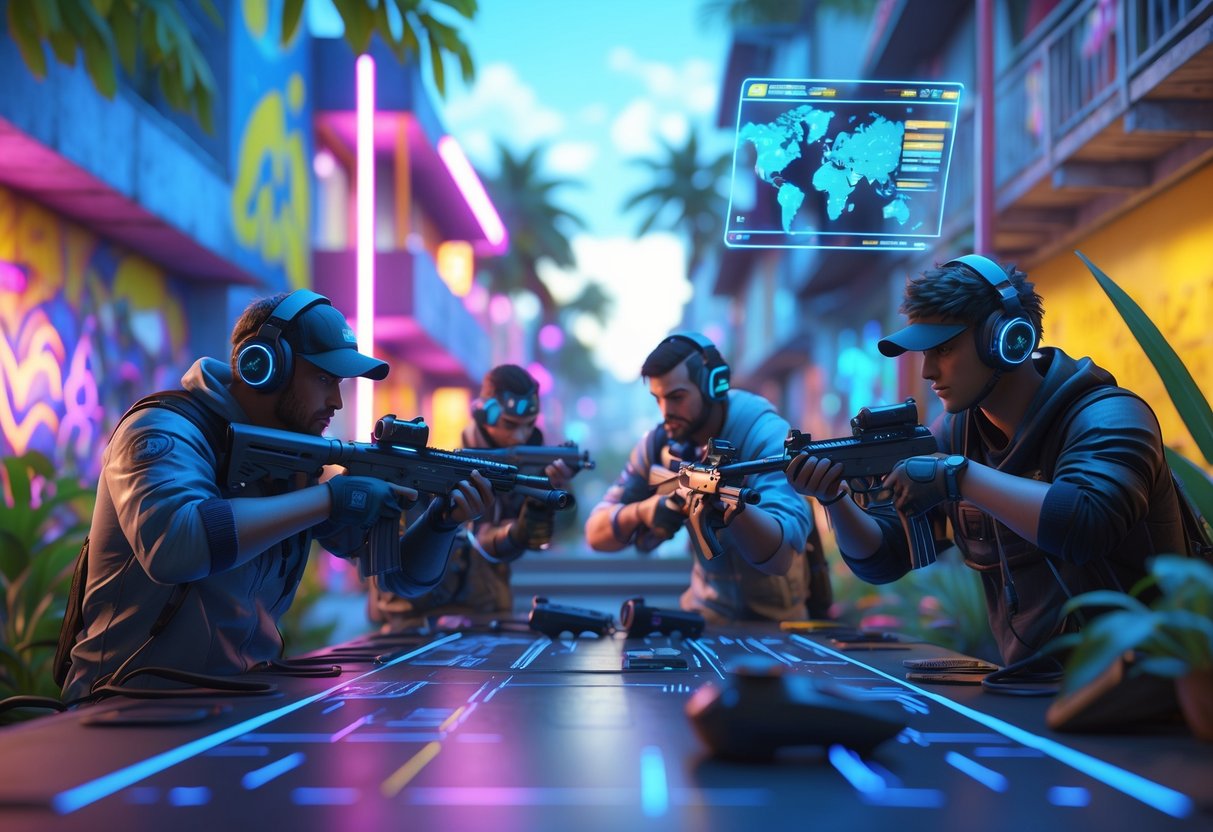
Brazil’s now the biggest gaming market in Latin America, with over 103 million players and billions rolling in every year. Even with global market hiccups, Brazil just keeps growing—mobile gaming leads the charge, and a wide mix of players keeps demand high.
Growth and Revenue Statistics
The Brazilian gaming market hit $5.21 billion in 2024 and experts think it’ll double to $10.60 billion by 2033. That’s a steady 8.2% annual growth from 2025 to 2033.
Brazil’s gaming revenue has shot up in recent years. Back in 2017, it was just $850 million. By 2023, it exploded to $5.78 billion—more than six times higher in only six years.
Revenue milestones:
- 2017: $850 million
- 2023: $5.78 billion
- 2024: $5.21 billion
- 2033 (projected): $10.60 billion
Even when the global market dipped 4.3% in 2022, Brazil still managed to grow by 3%.
Brazil now ranks as the fifth largest gaming market by online population and sits at number ten globally for video game revenue as of 2022.
Market Trends in 2024
Mobile gaming rules the scene in Brazil. By 2023, 92.5% of households with internet had a smartphone, making mobile games the easiest way in.
Esports and competitive gaming have totally reshaped Brazil’s gaming world. Big tournaments draw wild crowds, and Brazilian teams are now regulars on the world stage. Team Liquid even opened a massive esports facility in São Paulo in 2023, stretching across 13 floors.
Console gaming is making a comeback as next-gen consoles get cheaper. Middle-income city dwellers are snapping up PlayStations, Xboxes, and Switches, and sales keep climbing.
Local game studios are thriving too, with indie devs getting government support. That means more games that actually speak to Brazilian culture and tastes.
Digital payments like PIX and e-wallets make buying in-game stuff super easy. That’s pushed up player spending and helped publishers make more money.
Demographics of the Gaming Audience
Brazil has over 103 million gamers in 2024—the biggest crowd in Latin America. That’s about half the whole country.
The player base is all over the map when it comes to age and gender. Gaming’s not just for young guys anymore—more women and older adults are getting into mobile and casual games.
Gamers are everywhere:
- Southeast (biggest market)
- South
- Northeast
- North
- Central-West
Disposable income for Brazilian gamers has jumped a lot. Household disposable income hit 711.54 billion BRL in November 2024, up from 698.65 billion BRL the month before.
With more spending power, gamers are buying better hardware and services. PC gaming is on the rise as players chase better graphics and bigger game libraries.
Streaming and content creation are massive in Brazil. Tons of influencers stream on Twitch and YouTube Gaming, and millions tune in regularly.
Key FPS Titles Fuelling Brazilian Success
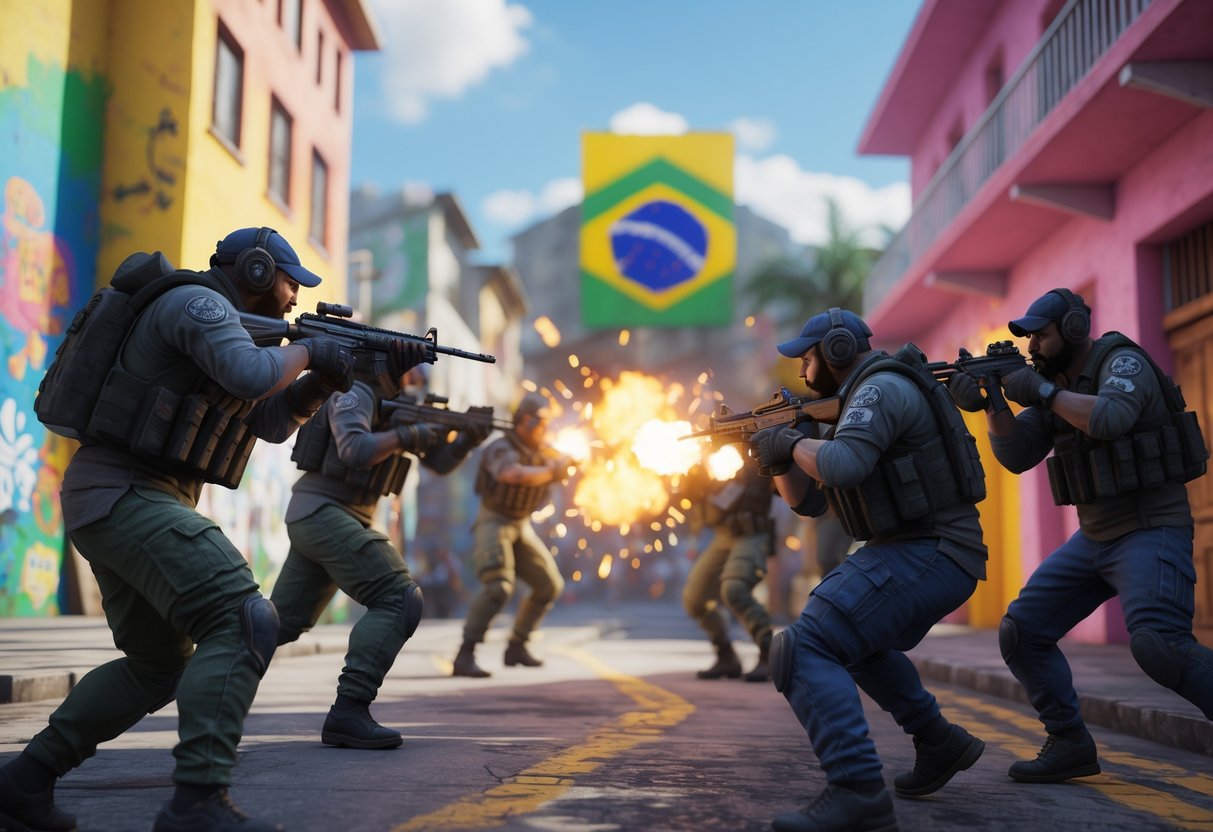
Brazil’s FPS reign covers three huge games—Valorant, CS, and Rainbow Six Siege. Teams have grabbed world titles in all of them, and each game has added something different to Brazil’s tactical rep.
Valorant Achievements
LOUD made history at Valorant Champions 2022. They became the first team from outside North America or Europe to win a major international Valorant trophy. On September 18th, 2022, they beat OpTic Gaming 3-1 in the grand final.
That win came from some wild individual plays. Bryan “pANcada” Luna kept landing crucial entry frags, even scoring double kills while totally blinded in the final round on Haven.
Highlights:
- First non-Western region to win Valorant Champions
- Beat OpTic Gaming after losing to them three times earlier in 2022
- Put Brazil on the Valorant map, big time
This win made Brazil the only country to hold world titles in all three big tactical FPS games at the same time. LOUD’s run inspired more Brazilian teams to shoot for the top.
Impact of CS
Gabriel “FalleN” Toledo shook up Brazilian Counter-Strike by leading his teams to two Major wins in 2016. First, Luminosity Gaming took the MLG Major Championship Columbus, then SK Gaming won ESL One Cologne.
These victories showed Brazilian teams could hang with Europe’s best. Marcelo “coldzera” David stepped up as one of CS’s top players, topping HLTV rankings in 2016 and 2017.
FalleN did more than just win games. People call him Brazil’s Counter-Strike godfather because he’s spent years building up the country’s esports scene and mentoring new talent.
Big moments:
- Two Major championships in 2016
- Coldzera ranked world’s best player twice
- Brazil became a tier-one CS region
In 2024, Brazilian CS teams kept climbing, with several breaking into the world’s top 50 and showing the region’s staying power.
Rainbow Six Siege Triumphs
Brazilian teams have owned Rainbow Six Siege, especially in 2021 when all three top teams at the Six Invitational came from Brazil. Ninjas in Pyjamas finally took their first big title, beating Team Liquid to lift the championship hammer.
Brazil’s Siege victories come from tactical innovation and flashy individual skill. Brazilian players collected 10 different EVP awards at international events in 2021, plus all three SiegeGG Event MVPs.
Standout achievements:
- Ninjas in Pyjamas won Six Invitational 2021
- All top three Six Invitational 2021 teams were Brazilian
- Dominated individual awards at multiple tournaments
Recently, teams like w7m have reached grand finals, finishing as runners-up at major events. That kind of consistency just proves Brazil’s place as Siege’s powerhouse region.
Iconic Brazilian Esports Organisations
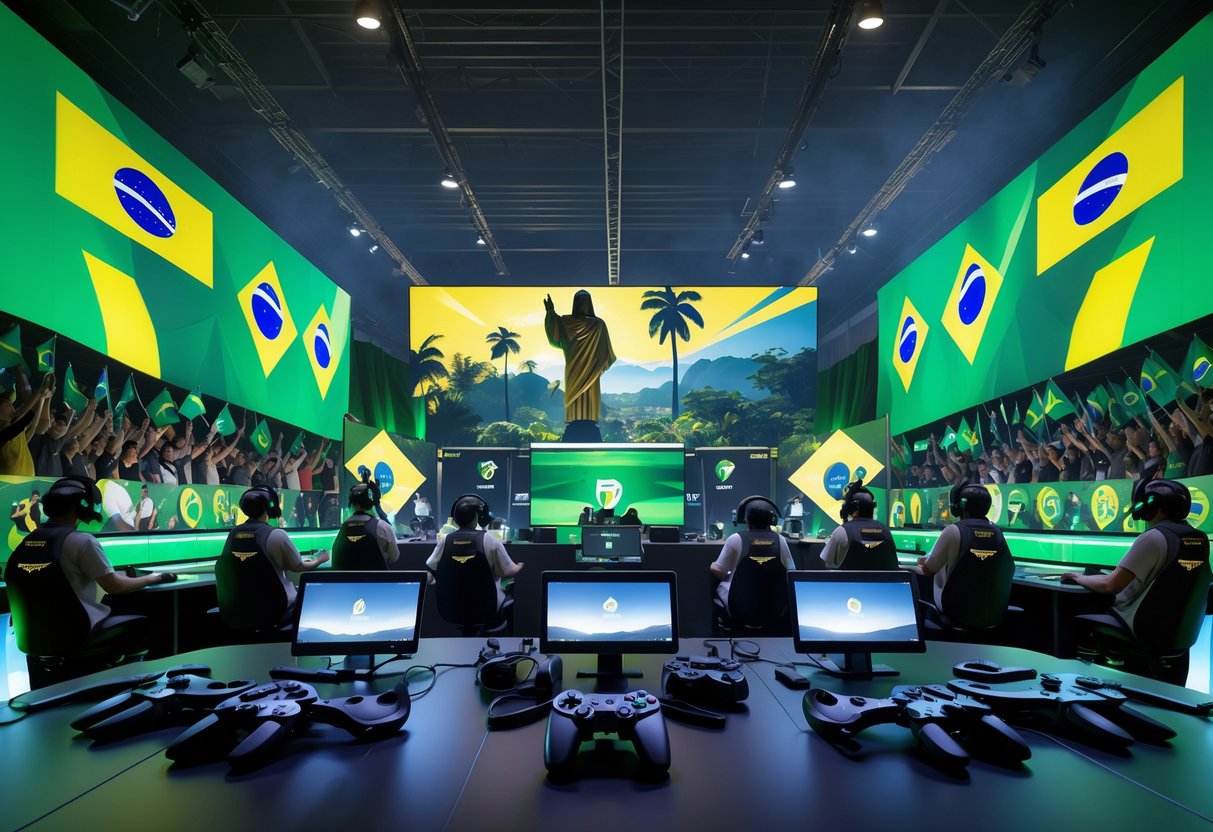
Brazil’s FPS dominance owes a lot to powerhouse orgs like LOUD, who took Valorant’s biggest trophy, plus mainstays like FURIA and w7m. These teams have built some of the most loyal fan bases around and shown that Brazilian shooters can take on anyone.
LOUD and Its Rise
LOUD exploded onto the world stage. They made history at Valorant Champions 2022, becoming the first team outside North America and Europe to take home an international trophy.
Their win came thanks to some wild clutches. Bryan “pANcada” Luna pulled off huge plays, even when he was completely flashed—just raw Brazilian talent on display.
LOUD’s big wins:
- 2022: Valorant Champions winners
- First Brazilian org to win a major Valorant event
- Beat OpTic Gaming 3-1 in the final
LOUD leaned on Brazil’s FPS roots. Coach Matheus “bzkA” Tarasconi even said that Gabriel “FalleN” Toledo’s approach inspired their work ethic.
That victory proved Brazilian orgs could go toe-to-toe with the world’s best in Valorant. It also completed Brazil’s rare sweep: world titles in Valorant, CS, and Rainbow Six Siege.
Role of w7m and FURIA
FURIA stands out as one of Brazil’s most steady FPS orgs. They’ve put together strong squads across several games, especially CS, where they regularly challenge European giants.
The org’s secret sauce? They focus on growing homegrown talent. FURIA’s players usually come up through Brazil’s hardcore FPS community, often with little more than passion and grit.
w7m leans into content creation as much as competition. They blend entertainment and esports, which helps them keep fans engaged and build a lasting following.
What sets them apart:
- Solid player development programs
- Big social media presence (especially in Portuguese)
- Regulars at international tournaments
Both orgs show how Brazilian esports mixes heart and professionalism. They keep the talent pipeline flowing and aren’t afraid to battle it out on the world stage.
Other Influential Teams
A bunch of other Brazilian organizations have really shaped FPS success in their own ways. Ninjas in Pyjamas’ Brazilian roster absolutely dominated Rainbow Six Siege, pulling off a huge win at the 2021 Six Invitational.
Team Liquid expanded operations in Brazil in 2022 and doubled down even more in 2023. You can tell international orgs see Brazil’s esports market as a massive opportunity right now.
Luminosity and SK Gaming—those classic names, especially with FalleN’s iconic CS lineups—paved the way for everyone else. They actually pulled off back-to-back Major wins at MLG Columbus and ESL Cologne in 2016.
Impact of smaller organisations:
- Grow regional talent pools
- Build competitive domestic leagues
- Offer stepping stones to international teams
A lot of Brazilian players kicked off their careers with smaller local orgs before landing on the big teams. This kind of ecosystem keeps the talent pipeline flowing for a gaming community that’s now over 9.2 million strong.
Star Brazilian FPS Players
Brazilian gamers have given the world some truly legendary FPS figures. Whether it’s Valorant world champs, CS all-timers, or Rainbow Six powerhouses, these players have changed how people think about competitive shooters.
Notable Figures in Valorant
Bryan “pANcada” Luna is easily one of Valorant’s most clutch players. His double entry kills in the Champions 2022 final helped LOUD grab Brazil’s first world title. Even when he got completely flashed, pANcada still landed those crucial frags and put Brazil on the Valorant map.
Matheus “Sacy” Delipoveli brought some serious veteran leadership to LOUD’s championship run. His smart plays and steady performance made him one of the most respected initiators out there.
LOUD’s roster shook up how teams think about tactical rounds. Their victory over OpTic Gaming was the first time a region outside North America or Europe actually took home an international Valorant trophy.
Matheus “bzkA” Tarasconi, LOUD’s coach, says a lot of their philosophy comes from lessons learned watching CS legends. His tactical style mixes that classic Brazilian aggression with sharp team play.
Legends from CS
Gabriel “FalleN” Toledo is basically the godfather of Brazilian Counter-Strike. He led his teams to back-to-back Major wins at MLG Columbus and ESL One Cologne in 2016. His Luminosity and SK Gaming squads showed the world that Brazilian teams could actually compete with the best in Europe.
FalleN didn’t just win trophies. He spent years building Brazil’s esports infrastructure and inspiring new players.
Marcelo “coldzera” David was a monster during CS’s peak. He topped HLTV’s world rankings in both 2016 and 2017. Plenty of analysts still call him one of the best fraggers in CS history.
They really were the ultimate underdogs. Europe ran the show for a long time, so Brazil’s Major wins felt even bigger.
Breakout Rainbow Six Talents
Brazil’s Rainbow Six scene has exploded lately. In 2021, the top three teams at the Six Invitational were all Brazilian.
Ninjas in Pyjamas finally got their moment in May 2021, beating Team Liquid to win Brazil’s first R6 Invitational championship. After finishing second the year before, that win had to feel extra sweet.
Brazilian R6 teams changed the game with their aggressive play and creative site takes. International teams had to rethink everything after seeing them in action.
Brazil’s depth in Rainbow Six is wild. Several Brazilian rosters keep making international finals, so the domestic competition just keeps getting fiercer.
Cultural Drivers Behind FPS Popularity
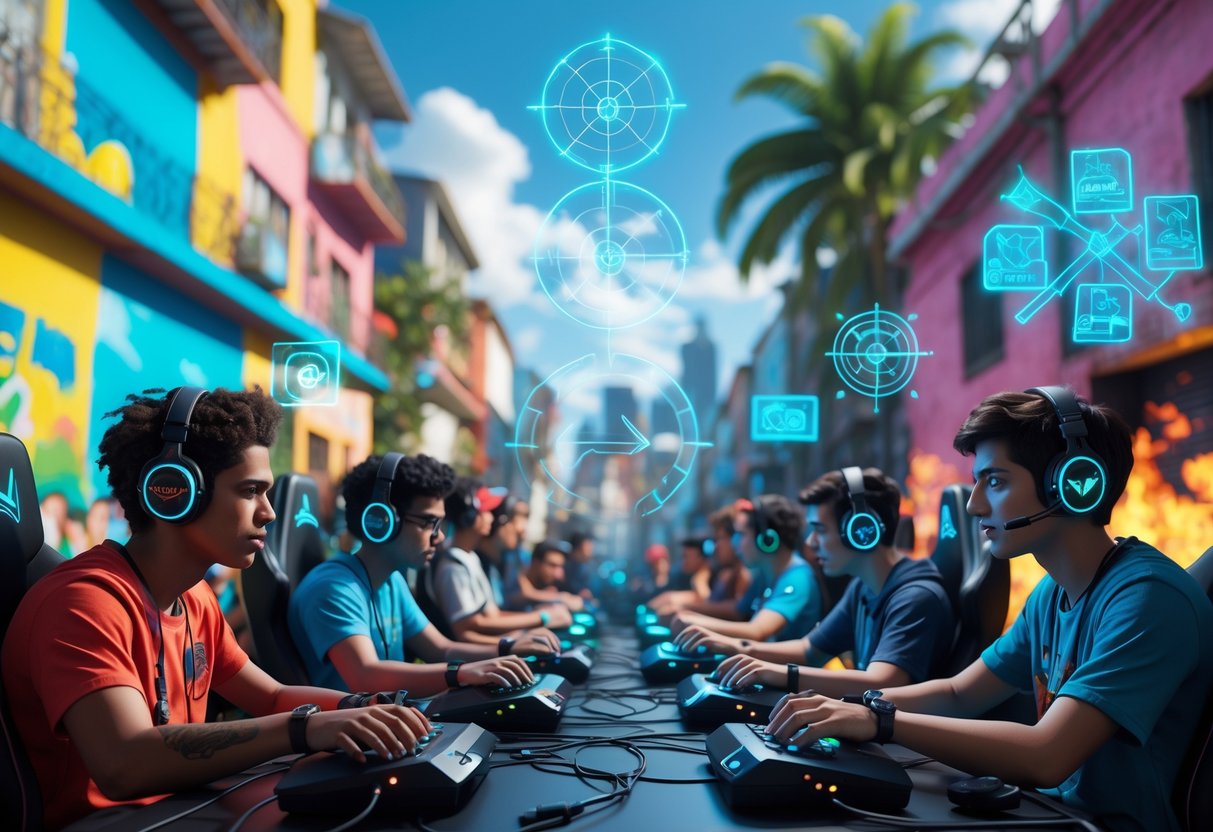
Brazil’s gaming culture blends a real love of competition with tight-knit communities and classic sporting values. It’s honestly the perfect recipe for FPS games to thrive.
Passion for Competition
Competition is just part of life in Brazil. You see it everywhere, from football matches to carnival games.
Brazilian gamers bring that same fire to FPS titles. They’ll grind for hours every day, treating gaming as a real pursuit—not just a casual hobby.
Football culture teaches teamwork and strategy. Those skills slide right into tactical FPS games like CS and Valorant. Brazilian players know that talent only goes so far without team play.
Local gaming cafés host tournaments that feel just like neighborhood football matches. People play for pride and maybe a small prize. This grassroots scene lays the groundwork for future pros.
Brazilians love the underdog story. Teams like LOUD showed that South American squads could beat the favorites from Europe and North America. That kind of upset inspires the next wave of gamers.
Social Dynamics and Community
Gaming in Brazil is rarely a solo thing. Friends hang out in internet cafés or at home to play together. That social vibe makes FPS games way more appealing than single-player stuff.
Brazilian gaming communities are super welcoming. Veteran players help out newcomers on Discord or at local meetups. New players pick things up quickly in that kind of environment.
Language barriers don’t stop Brazilian teams from competing globally. But you’ll notice they usually play their best when speaking Portuguese. Team chemistry becomes everything in those high-pressure moments.
Streaming is huge in Brazil. Streamers turn into local celebrities who totally influence what people play. When a big streamer dives into an FPS, their whole audience usually follows.
Parallels with Traditional Sports
Football tactics are basically FPS strategies in disguise. Brazilian football is all about creativity, quick thinking, and adaptability. Those same traits make for great FPS players.
Traditional sports in Brazil reward both flashy individual plays and team wins. FPS games do the same, and that balance really clicks with Brazilian fans.
The “jeitinho brasileiro” (Brazilian way) shows up in gaming too. Teams find clever ways to beat better-funded opponents. That creativity leads to tactics that catch international teams off guard.
Pro gaming now offers chances similar to traditional sports. Young Brazilians see esports as a real career option, right alongside football or volleyball.
Technological and Market Advancements
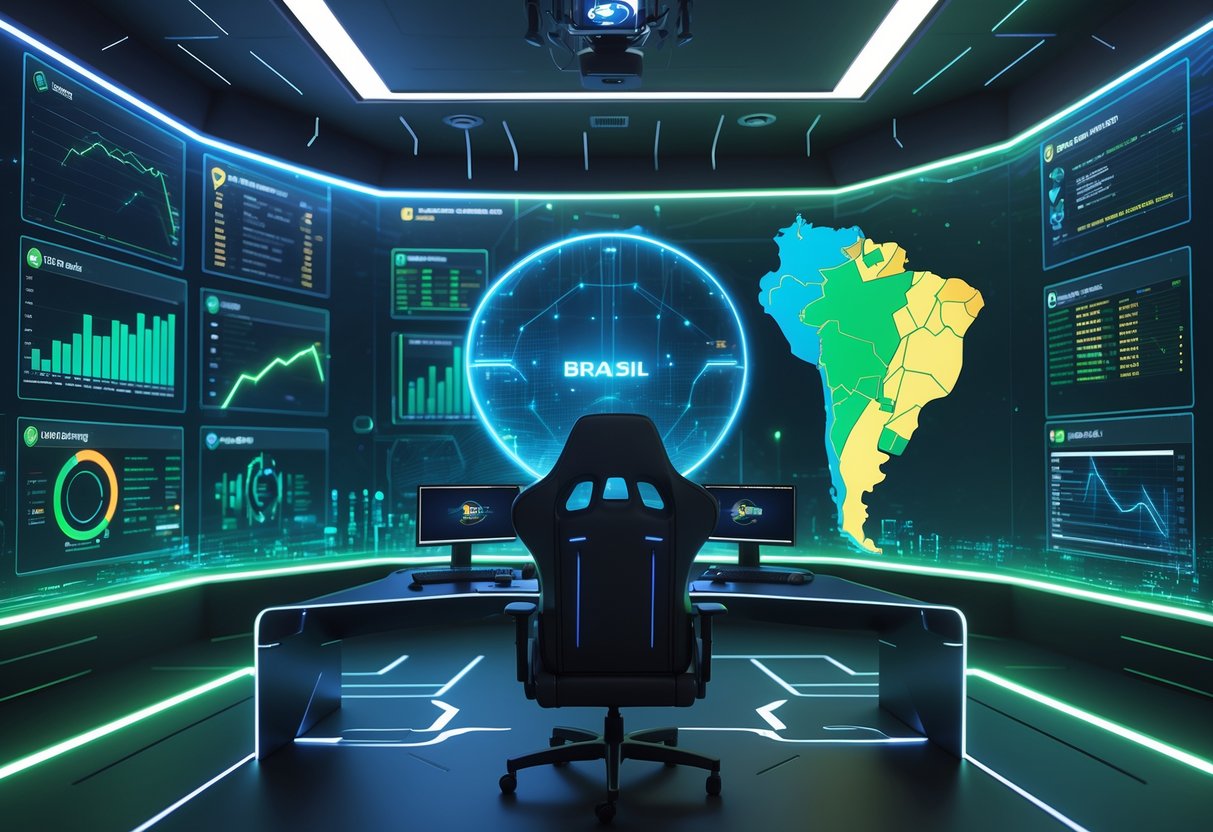
Brazil’s FPS dominance really took off because of three big tech shifts. Mobile gaming blew up, high-speed internet reached way more people, and local gaming studios started expanding fast.
Mobile Gaming Surge
Mobile devices changed the game for FPS fans in Brazil. With over 215 million people and smartphones everywhere, mobile gaming quickly became the top way to play shooters.
Key mobile FPS advantages in Brazil:
- Way cheaper than building a PC setup
- Lets people play without fancy hardware
- Social features fit perfectly with Brazil’s gaming culture
Modern smartphones can handle pretty complex FPS games now. That means players enter tournaments using the phones they already own.
The freemium model works great in Brazil. People download games for free, then buy upgrades or cosmetics as they get more into it.
Mobile esports tournaments are popping up everywhere. Brazilian teams even compete internationally using the same phones everyone else plays on.
Access to High-Speed Internet
Better internet has completely changed FPS gaming in Brazil. Now, reliable connections make online multiplayer actually work.
Infrastructure improvements include:
- More fibre optic networks in the big cities
- Lower latency for competitive play
- Stable internet for streaming tournaments live
Because of this, Brazilian FPS players can finally compete globally without tech holding them back. Lag and disconnects just aren’t the roadblocks they used to be.
Online multiplayer fits right in with Brazil’s social gaming style. People want those community-driven games that need a steady connection.
Live streaming is now a major part of FPS esports growth. Brazilian players can show off tournaments and gameplay to the world with no tech issues.
Expansion of Gaming Studios
Local gaming studios are really pushing innovation in Brazil’s FPS scene. They get what Brazilian players want and add cultural touches that international studios might miss.
Brazilian studios put a lot of focus on mobile-first FPS games. They design titles that work well with the devices and internet speeds people actually have.
Studio growth factors:
- Investing in local talent and dev teams
- Knowing the ins and outs of Brazilian Portuguese
- Understanding what local players like and want in social features
Cultural adaptation is now a must. Brazilian studios naturally weave in local humor, references, and stories that hit home with domestic players.
They also help the competitive scene by sponsoring tournaments and putting up prize money. Local investment makes the whole FPS ecosystem stronger.
With both technical skill and cultural insight, Brazilian studios have a real edge when it comes to making FPS games that work both at home and abroad.
Brazil’s FPS Dominance on the International Stage
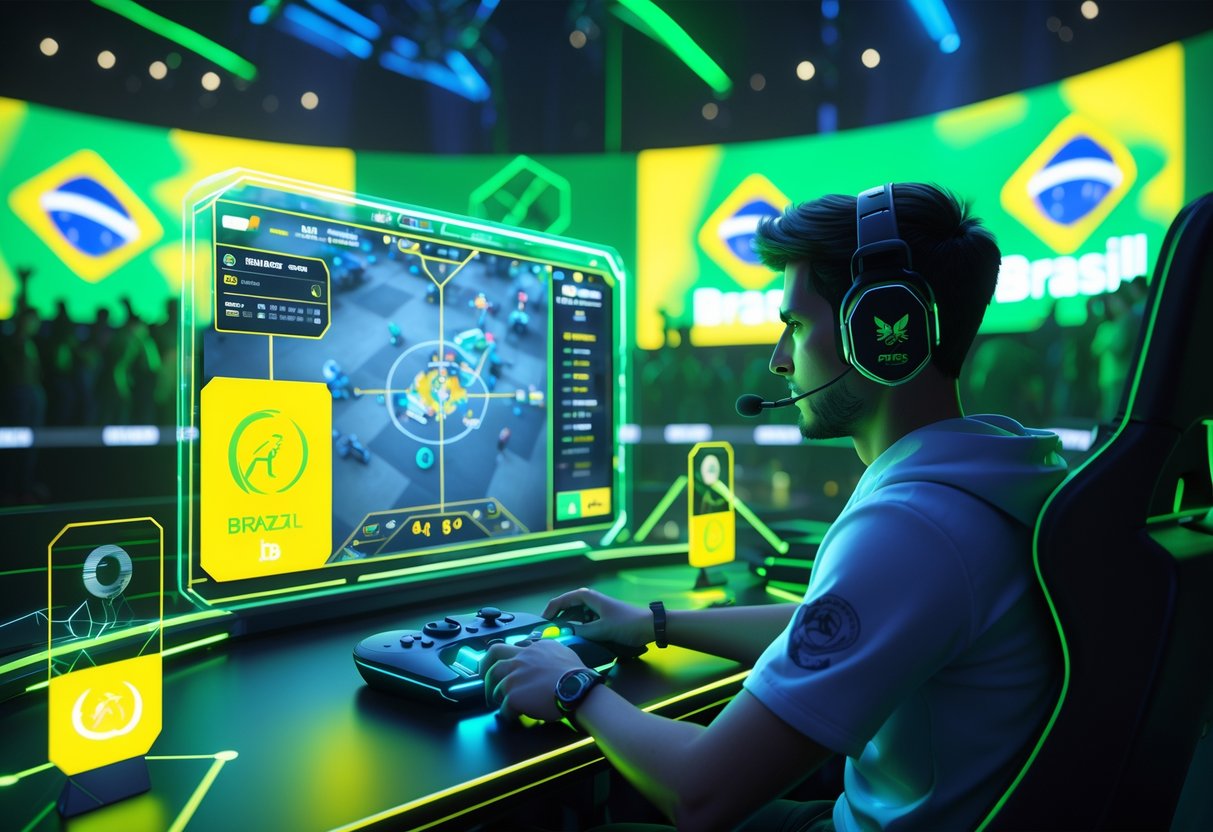
Brazilian teams have actually won world titles in Valorant, CS, and Rainbow Six Siege. That makes Brazil the only country to grab the biggest trophies in all three major tactical shooters. These wins came from truly dominant runs at global events, with Brazilian players often hitting finals and racking up MVP awards.
World Championship Titles
Brazil made esports history when LOUD won Valorant Champions 2022, beating OpTic Gaming 3-1 in the grand final. It was the first time a region outside NA or Europe lifted an international Valorant trophy.
That championship run was a wild ride. LOUD faced OpTic Gaming six times that year, splitting the wins, but when it really counted, they played their best.
In CS, Gabriel “FalleN” Toledo led his teams to back-to-back Major wins. His Luminosity roster took MLG Major Championship Columbus in 2016, then won ESL One Cologne 2016 as SK Gaming.
Those victories put Brazil on the map as a legit Counter-Strike powerhouse. Europe had held the throne for years before FalleN’s teams broke through.
Rainbow Six Siege brought even more glory. Ninjas in Pyjamas became Brazil’s first R6 world champs at the 2021 Six Invitational, beating Team Liquid for the $3 million prize.
That 2021 Six Invitational was something else. All three podium teams were Brazilian, showing just how deep the country’s R6 talent runs.
Performance in Global Tournaments
Brazilian teams keep making it to the late stages of major FPS tournaments. At international events, you’ll see Brazilian squads making deep runs and fighting for titles.
Just look at the numbers. In 2021, Brazil had 10 different players win tournament MVPs at overseas events. They also picked up all three SiegeGG Event MVP awards that year.
LOUD’s Valorant run is a great example of this consistency. They finished top three at a bunch of international LAN events in 2022. Guys like Bryan “pANcada” Luna built reputations for clutch plays when it mattered most.
CS legend Marcelo “coldzera” David topped HLTV’s world rankings two years in a row—2016 and 2017. Most people still consider him one of the best to ever play the game. His consistency at big international events was just unreal.
Brazilian players built this scene from humble beginnings. They didn’t have much money or support compared to Europe. Still, they built passionate communities that kept producing world-class talent.
The recent wave of success covers different generations. From FalleN’s early CS squads to LOUD’s Valorant champs, Brazil just keeps producing FPS stars on the global stage.
Media, Art, and Streaming Impact
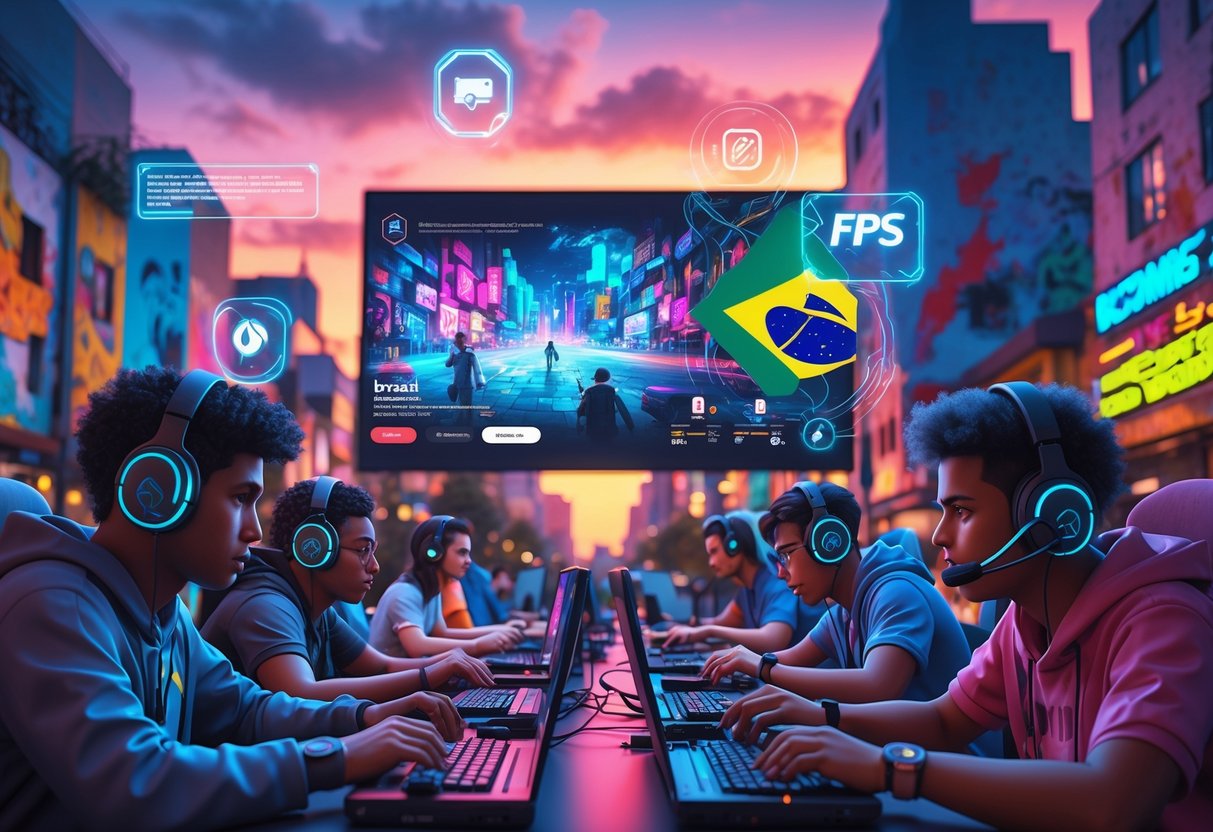
Brazil’s streaming platforms and content creators have totally changed how FPS esports connects with fans. The country’s passionate gaming community creates art and media that really celebrates their teams’ victories.
Streaming Culture in Brazil
Netflix leads the way in Brazil, where it claims 20.6 million subscribers. That makes Brazil the platform’s second-biggest market worldwide. This streaming culture spills over into gaming too.
Brazilian gamers devour FPS content on platforms like Twitch. When Imperial played Cloud9 at a major tournament, streamer Alexandre “Gaules” Borba pulled in over 700,000 viewers.
FAST (Free Ad-Supported Television) has made esports way more accessible. Loads of Brazilian fans now watch FPS tournaments through free streams instead of paying for subscriptions.
Mobile gaming really opened things up. About 41% of Brazilian gamers play on their phones, so streaming platforms had to step up and optimize for different devices.
| Platform Type | Market Share | Audience Focus |
|---|---|---|
| Netflix | 30% | General entertainment |
| Prime Video | 14% | Mixed content |
| Globoplay | 10% | Local content |
| FAST platforms | Growing | Free esports/gaming |
Esports Content Creation
Brazilian FPS content creators have built massive followings by focusing on local teams. They crank out match analysis, player interviews, and tournament highlights—all in Portuguese.
YouTube channels about VALORANT and CS often rack up millions of views. Creators follow teams like LOUD and FURIA as they travel to international events.
The IEM Rio Major really showed off the power of Brazilian content creators. Local streamers gave commentary that clicked with fans in ways international broadcasts just can’t.
Art matters a lot in this scene. Fan artists design team logos, player portraits, and even victory memes that spread everywhere on social media.
Content creators and teams work together a lot. They score exclusive interviews and sneak peeks behind the scenes—things international media rarely get.
Artistic Representations of FPS Fandom
Brazilian fans show their FPS love through all kinds of art. Street murals celebrating LOUD’s VALORANT win popped up in big cities.
Digital artists whip up championship posters and team mascots, mixing Brazilian culture with gaming vibes.
Fan videos often blend samba rhythms with tournament highlights. That unique flavor helps Brazilian FPS content stand out worldwide.
Art galleries in São Paulo have hosted gaming culture exhibits. These include tournament photography and digital art that honors Brazilian teams.
Sometimes, the crowd itself becomes art. Drums, flags, and wild chants turn tournaments into visual spectacles, and photographers love to capture those moments.
Social media just amplifies everything. Instagram pages dedicated to Brazilian FPS art have thousands of followers who share team tributes and celebration edits.
Community Initiatives and Grassroots Esports
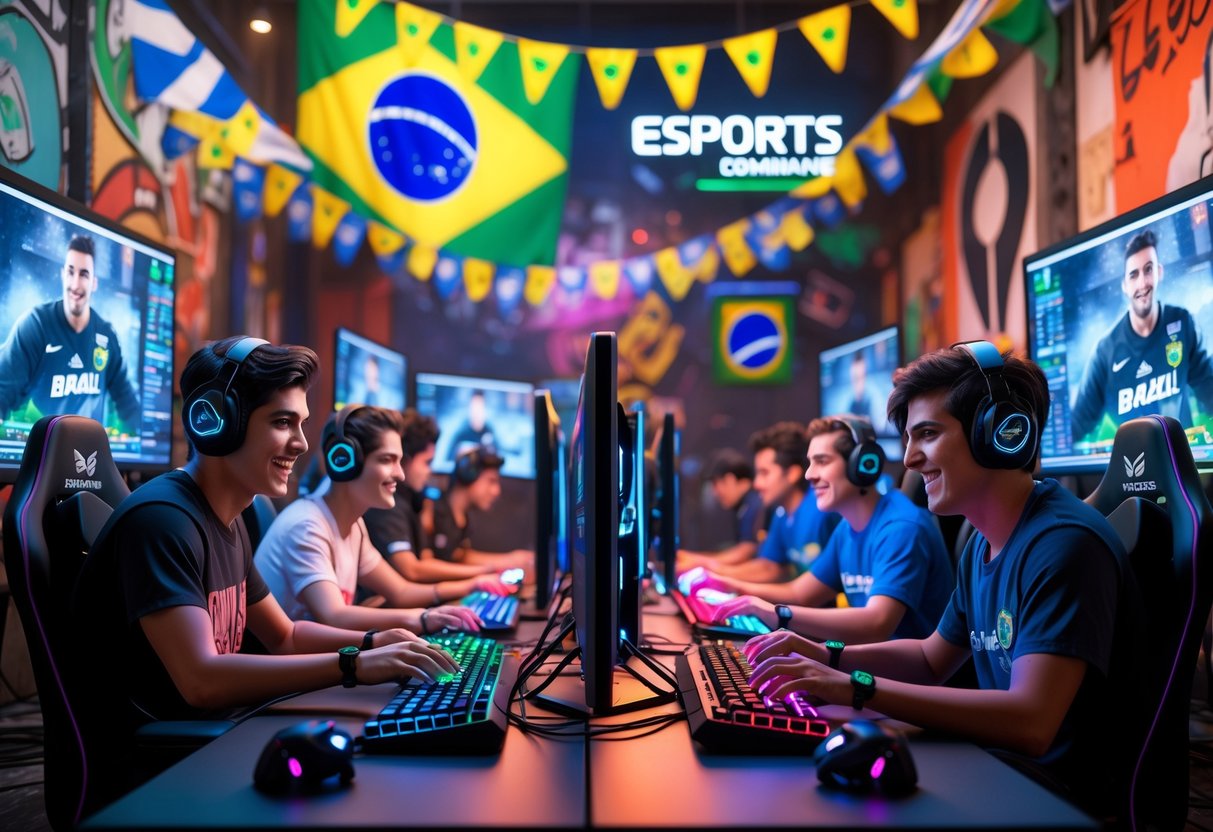
Brazil’s FPS scene thrives on local community support. Schools, gaming organizations, and local tournaments all pitch in to find and train new talent.
Local FPS Tournaments
Thousands of small FPS tournaments happen across Brazil every year. You’ll find them in gaming cafes, community centers, and schools in cities like São Paulo and Rio.
Most tournaments focus on Counter-Strike and VALORANT. Entry fees are pretty low—usually R$20-50 per player—which keeps things open to everyone.
Popular tournament formats include:
- Weekend knockout competitions
- Monthly league seasons
- School holiday championships
- University inter-campus events
Gaming cafes usually sponsor these tournaments. They provide PCs, internet, and sometimes prize money. Winners often get gaming gear, cash, or invites to bigger regional events.
Favelas have turned into grassroots esports hotspots. Community leaders organize tournaments to give young people something positive to do. These events draw big crowds and sometimes even create local heroes.
Support from Schools and Organisations
Brazilian schools are starting to see esports as a real activity. Lots of universities now offer esports programmes and scholarships for top players.
Team Liquid expanded in Brazil in 2022 and doubled down in 2023, focusing on talent development and community projects. They run coaching clinics and supply gear to promising players.
Private companies have jumped in too. They sponsor local teams, donate equipment, and help fund prize pools. This corporate support keeps tournaments running regularly.
Some schools even form their own esports teams. Students compete against other schools in organized leagues. Teachers sometimes step up as coaches, even if they’re not gamers themselves.
Gaming organizations use social media to keep everyone connected. Players share training tips, set up practice sessions, and help each other find sponsors.
Development Programmes
Brazil’s government sees the economic potential in esports. The National Plan for Development of Esports tries to build clear pathways for player growth.
Key programme features:
- Coaching certification courses
- Equipment grants for community centers
- Training facilities in major cities
- Mentorship programs that connect pros with amateurs
The gaming market here benefits a lot from high mobile phone use. Development programs target both PC and mobile FPS games, reaching players who don’t own gaming PCs.
Quick win: Many programs offer free weekend coaching. New players can just show up—no big commitment needed.
Youth engagement drives these programs. Organizers focus on players aged 14-24, when skills develop fastest. They provide structured training and goal-setting workshops.
Regional competitions lead to national tournaments. The best grassroots players get real shots at pro teams. That clear path keeps the community motivated.
Challenges and Opportunities for Future Growth

Brazil’s FPS scene faces some real challenges like talent retention and infrastructure gaps. But international partnerships and a booming Brazilian gaming market offer huge chances for growth.
Talent Retention Issues
Brazilian FPS talent often heads overseas for better opportunities. This hurts local teams and weakens the scene.
It’s easy to see why—many top players move to North American or European orgs for higher pay. Brazilian teams just can’t compete with those salaries.
Key retention challenges include:
- Smaller prize pools than international events
- Fewer sponsorships for individual players
- Not enough professional development programs
- Less media coverage and fan engagement
But things are changing. Some Brazilian orgs now offer performance bonuses and streaming revenue shares to keep talent at home longer.
Local academies have stepped up too. They’re looking at building full careers, not just focusing on raw gaming skill.
Infrastructure Investments
Brazil’s gaming infrastructure needs work if FPS is going to keep growing. Internet connections still vary a lot by region.
The Brazilian gaming market pulled in $251.6 million in 2023, but not enough of that goes into competitive infrastructure.
Critical infrastructure needs:
- Reliable high-speed internet everywhere
- Professional training centers
- Broadcasting gear and studios
- Better tournament venues
São Paulo leads the way with 302 game studios, but smaller cities often lack good facilities. That creates an uneven playing field for new talent.
Investment opportunities are getting bigger. Private companies see the potential in FPS esports, and government programs also back digital infrastructure.
Remote work helps a bit—70% of studios now run remotely—so players can compete from home if their internet is solid.
International Collaboration
Brazilian FPS teams gain a lot from international partnerships. These deals bring expertise, funding, and global exposure.
Western Europe now does business with 54% of Brazilian game studios, up from 49% in 2022. North American partnerships are still strong too.
Successful collaboration models include:
- Boot camps with international coaches
- Player exchange programs
- Joint tournament organization
- Shared training methods
Half of internationally active studios now make over 70% of their revenue from abroad. That shows just how important global connections have become.
International brands are sponsoring more Brazilian FPS teams. They know Brazil’s 103 million player market is a goldmine.
Language barriers are still tricky, though. Many Brazilian players struggle with English during international events.
Bilingual coaching programs and cultural exchange initiatives can help. These let Brazilian talent compete globally while keeping their own style.
The Lasting Legacy of Brazilian FPS Excellence
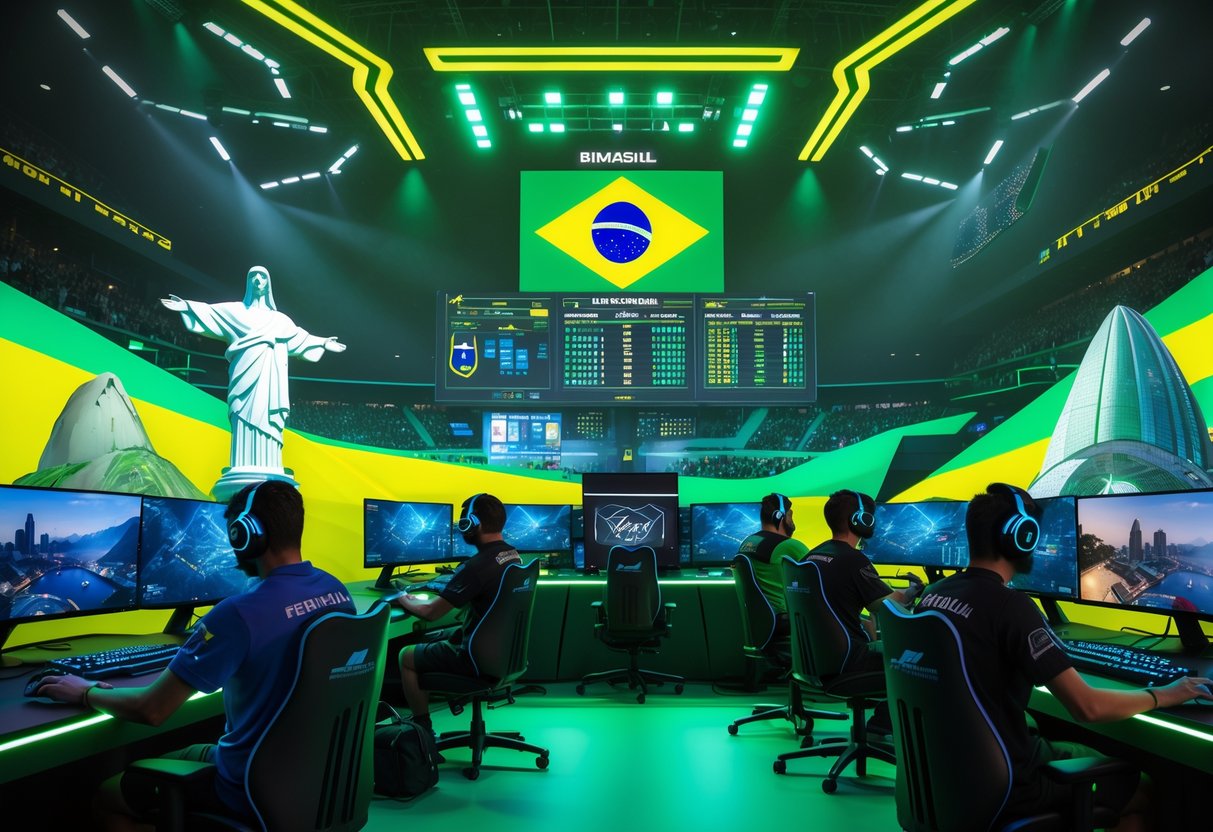
Brazil has set the standard for FPS success, and now other regions try to copy their blueprint. The country’s unique mix of raw talent and creative strategies has changed how teams everywhere approach competitive gaming.
Impact on Global Esports
Brazilian teams have forced everyone else to rethink their FPS strategies. European squads now study Brazilian rotations and retake moves.
People used to say some tactics just weren’t possible. Brazilian players proved them wrong. Their aggressive retakes in Valorant, for example, went from a 30% global success rate to 76% for the best Brazilian teams.
The impact isn’t just local. Major orgs like Fnatic and G2 Esports now hire Brazilian coaches. These coaches bring tactical ideas that European teams never even considered before.
| Region | Win Rate vs Brazil 2024 | Win Rate vs Brazil 2025 | Change |
|---|---|---|---|
| Europe | 68% | 42% | -26% |
| North America | 71% | 39% | -32% |
| Asia | 64% | 48% | -16% |
The money side is huge, too. Brazilian players now get transfer fees over £1 million. Teams everywhere are scouting Brazilian talent pools that barely got noticed five years ago.
Tournament organizers have changed formats to match. Big events now schedule matches for Brazilian prime time. The viewership boost from Brazilian fans makes these tournaments way more profitable.
Future Stars in the Making
Brazil’s youth development system keeps the talent flowing. Gaming academies across the country spot promising players as young as 14.
The infrastructure keeps getting better. New training centers open every month in big cities. These places offer coaching that older generations never had access to.
Ana “Viper” Costa’s success opened doors for female players. Mixed-gender teams are now pretty normal in Brazilian FPS, which doubles the talent pool.
Some rising stars are still under 18 and already competing internationally. Diego “Phantom” Silva hit millionaire status before turning 19. His story inspires thousands of young Brazilian gamers.
Academies teach more than just aiming and tactics. Players learn English, media skills, and how to handle their finances. That way, they’re ready for international teams when the time comes.
Global scouts now show up at regional tournaments. Every major org keeps talent spotters in Brazil. The next wave of Brazilian FPS stars could earn even more than today’s heroes.
Frequently Asked Questions
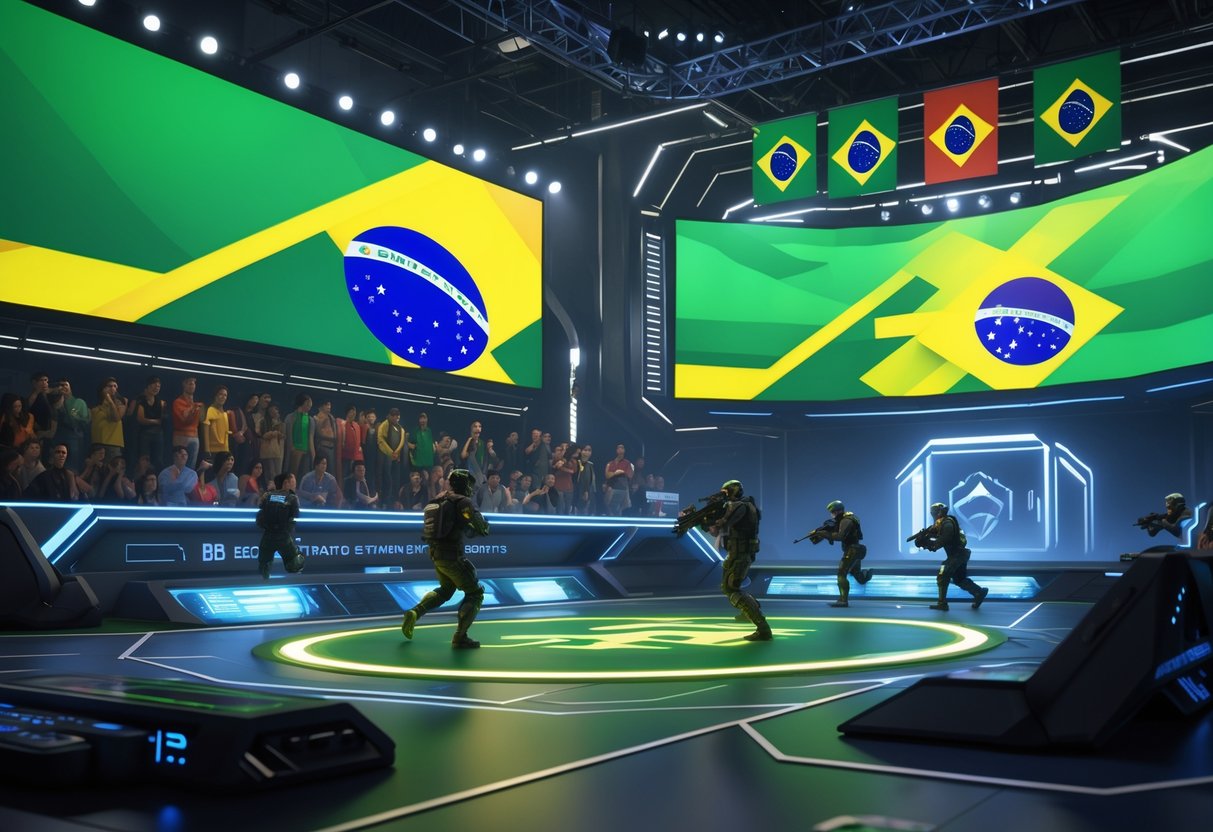
Brazilian FPS teams have found success by building passionate communities, using creative training, and forging strong team chemistry even when resources are tight. These players have changed global esports by bringing bold tactics and fearless gameplay that top teams now try to copy.
What has contributed to the success of Brazilian players in competitive FPS games?
Brazilian FPS players succeed thanks to a mix of passion and resourcefulness. Most start with basic gear in internet cafés and develop their skills through grit and determination.
The community makes a huge difference. Brazilian players support each other, share strategies, and build tight teams that communicate under pressure.
Having fewer resources actually helps sometimes. When you can’t buy the best gear, you end up with better teamwork and game sense. That makes Brazilian players super adaptable.
Their aggressive, creative playstyle surprises international teams. While European squads stick to rigid tactics, Brazilians improvise and take risks that often pay off.
How has Brazil’s gaming culture influenced its FPS scene?
Brazil’s gaming culture revolves around community spaces like LAN houses and internet cafés. These social spots naturally build the teamwork you need for FPS games.
Brazilian gamers bring a competitive spirit from football culture. That means intense practice and fierce loyalty to their teams.
People here love action-packed games, so FPS titles are a natural fit. Most players go for fast, skill-based games rather than slow strategy ones.
Free-to-play games dominate in Brazil, so almost everyone starts with accessible FPS titles. This creates a huge talent pool where the best rise up based on skill, not expensive equipment.
What are the top Brazilian FPS teams, and what have been their biggest achievements?
FURIA really stands out as Brazil’s most recognized CS2 team on the international stage. They keep showing up in major tournaments and have pulled off some big wins against tough European teams.
LOUD takes over the Valorant scene with an aggressive, unpredictable flair. Their tactical twists have actually changed how teams everywhere play certain maps.
Imperial Esports brings a sense of Brazilian CS2 tradition, with veteran players who’ve stuck around for over a decade. Their experience adds stability and a lot of leadership to the mix.
These teams keep landing top spots in tournaments and rake in serious prize money. They attract a lot of attention from around the world, which has helped open doors for younger Brazilian players trying to break into global organizations.
Can you explain the training regimen of Brazilian FPS players?
Most Brazilian teams train somewhere between 8 and 12 hours every day. They split that time between working on individual skills and running team strategy sessions.
Usually, mornings go to aim training and sharpening mechanics. In the afternoon, teams dive into tactical drills and focused team practice.
They spend a lot of time watching footage of their opponents, especially European and North American teams, looking for strategies to counter. More recently, physical fitness and mental health have become a real part of these routines.
A lot of top teams now add exercise and mental support to keep players at their best. After each match, everyone sits down for demo reviews, breaking down mistakes frame by frame and talking through positioning or communication problems with coaches.
What impact have Brazilian FPS players had on the global esports community?
Brazilian players brought a bold, risk-taking style that shook up the way people play FPS games. Their gutsy moves—sometimes they look impossible—have actually inspired teams everywhere.
They’ve shown that passion and teamwork can beat out bigger budgets. Even with less money than European or North American organizations, many Brazilian teams still pull off top results.
Their success has really boosted the Latin American esports scene. Now, tournament organizers almost always want Brazilian teams because of their huge, loyal fanbase.
People all over study their tactical creativity. European teams now mix in some of that Brazilian-style aggression and unpredictable positioning into their own strategies.
How do upcoming Brazilian talents enter the competitive FPS arena?
Most players kick things off in local internet cafés. They dive into small tournaments, where the prize pools rarely go beyond a few hundred reais.
These grassroots competitions spot raw talent pretty early on.
Online ranked ladders are really where scouts pay attention. If you keep landing in the top ranks, semi-professional teams start to notice and might reach out.
Academy teams step in as the next big opportunity. Major organizations like FURIA and LOUD actually run development programs, offering coaching and resources to help young players grow.
Community connections? Absolutely essential. Established players often vouch for newcomers, passing their names to team managers and opening doors through Brazil’s tight-knit FPS scene.

